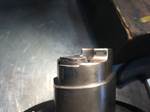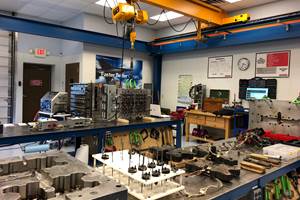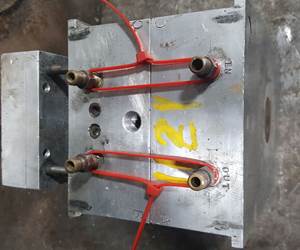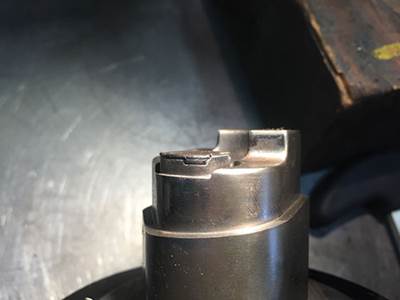Under the Scope: Considerations for Mold Repair Welding
This new series is intended to arm toolmakers and engineers with the necessary knowledge to make better informed decisions during tool repairs, including an understanding of welding terminology, procedures and challenges.
A necessary part of mold maintenance and repair is welding. This includes processes such as TIG (tungsten inert gas), micro-TIG and laser welding. Many welding shops have experience in all three processes, while others specialize in only one. Whether you are performing weld repairs in-house or outsourcing the work to a professional welding house, the success and quality of a repair weld depends on the level of difficulty, welding machine capabilities, welder skill and experience, and most importantly, communication.
For example, the welder must fully understand customer expectations, and the customer should be informed of any risks and considerations before welding begins. The golden rule of welding is: “What has been welded cannot be unwelded.” Any mistakes need to be machined away to start fresh, so it’s essential that all parties involved are on the same page when it comes to project details, process decisions and potential problems.
Every repair job is unique to a welder with each one requiring a different hand movement and position, and different machine calibration. This means clarity is essential for everyone involved. No one should work on assumptions, so never assume the welder knows what you want. Molds arrive on the welder’s bench for many reasons, including engineering changes or inoperability due to damage during the molding process. To properly prepare for and ensure optimal mold repair, essential questions must be asked and answered.
Questions
What am I welding? A welder must understand what the moldmaker requires in order to get the tool running again in a timely fashion. The welder also needs to know what the moldmaker does not want, such as surface areas that do not undergo any welding or experience the effects of welding.
Where am I welding? The location of a repair is critical to its success. The welder must know if his or her equipment, whether a TIG-welding torch or a laser-welding head, can successfully access the area to be welded. To determine this, it is often recommended that the welder position the piece on the worktable and perform a simulation weld to test ease of access.
What is the steel type? Each steel has its own guidelines for TIG welding, preheating and post-heating. Each type of steel also has its own welding parameters, which may include matching the steel with the proper filler rod to complement the base steel hardness and chemical composition. For example, the brittleness of die steels makes them behave quite differently from mold steels under any welding process. Cracking can occur, so special welding procedures are required. The physical properties of aluminum and copper-based materials limit the effectiveness of TIG or micro-TIG welding on them, as the repair will often require a small weld deposit that is best performed by laser welding.
What could go wrong? One problem scenario is when the welder unintentionally damages a mold area by arcing with a TIG-welding torch. This occurs because the arc is unstable upon initial welding startup and causes the arc to wander or hunt, thus producing unintended damages. Another example of welding gone wrong is the beam reflection that can occur when laser welding under certain conditions. Here, the laser beam reflects like a mirror, causing a melted surface opposite the location from which the laser beam originated. This effect can happen when welding highly reflective details, such as a polished finish or an angle.
In addition to asking these questions and receiving feedback, it is important for the welder to know if the customer is specifically requesting laser or micro-TIG welding, as well as the reasons behind this request, as there are advantages and disadvantages to both processes.
Considerations
Size. Mold size may dictate the appropriate welding process. A laser welder is in a fixed position and cannot be moved, so any repair has to be positioned exactly beneath the laser head. This limits the size of the mold that can be repaired with this type of welder. Large laser welders with moveable arms are available that provide better access for larger molds, but this requires a long setup process. A TIG welding torch, on the other hand, can be moved around and positioned by an arm or wrist. This greatly increases mobility and eases the welding of large molds. However, this flexibility must be weighed against the pinpoint accuracy of laser welding, which cannot be achieved by other processes.
Time. Laser welding does take longer than micro-TIG welding for certain weld repairs because of the laser’s fixed position, but this process does greatly reduce distortion and creates smaller welds. Micro-TIG welding can produce larger weld deposits faster and more efficiently, but weld sink (material shrinkage) and cracking around the heat affected zone (HAZ) can be a problem. This sink can occur when the weld cools too rapidly, causing a contraction or ring of depression around the area where the weld meets the base material. To combat this effect, anything TIG-welded should receive a proper preheat and post-heat treatment to reduce the contraction effect. Following steel manufacturer specifications is advised.
Damage. Weld sink and cracking are rarely problems for laser welding, as this process uses a wavelength of light concentrated in a tiny area. Most materials don’t require a preheat to be laser welded, however, laser welding is more susceptible to porosity (imperfections in the weld), since a laser beam does not have sufficient power to break through rough surfaces such as an EDM finish. Most importantly, a laser welder can repair tiny details and small molds, which would bend or distort from the excess heat generated by a TIG or micro-TIG welder.
No matter which process is selected, there are challenges to achieving the optimal mold repair. Following are the top two problems welders encounter.
Problems
Access. Access to the welding area is the most critical and most common challenge a welder faces, as mold damage and engineering changes are often in areas that are difficult to reach. This is especially true when the revisions are in deep cavities, as any impurities (such as dirt, grease or oil) also require cleaning and grinding to achieve an optimal repair. Special coatings or platings on the mold surface are another problem, as they can cause porosity and/or surface cracking, which results in lesser weld quality.
Re-cast layer. Another challenge to achieving optimal mold repair is an EDM finish’s hardened re-cast layer, which can act as a barrier to the weld puddle. On a TIG machine, this requires increased welding amperage to break through the hardened surface layer. However, this increased amperage yields a difficult-to-control weld puddle that can cause unintended damage to surrounding details. On a laser welder, an EDM finish inhibits the laser beam from breaking through the re-cast layer, resulting in porosity and miniature surface cracking. The only solution here for either process is to grind down the re-cast layer as best as possible. In future articles, we will dig deeper into this particular welding problem.
Remember that collaboration between welder and customer is key when discussing a mold repair project and prior to making a final decision on the appropriate welding process. This collaboration should help to identify a better and simpler way to perform a weld repair. Next month, we will review understanding and diagnosing the repair task at hand.
Related Content
What You Need to Know About Hot Runner Systems and How to Optimize Their Performance
How to make the most out of the hot runner design, function and performance.
Read MoreLaser Welding Versus Micro Welding
The latest battle in finely detailed restoration/repair of mold materials.
Read MoreWhat is Scientific Maintenance? Part 2
Part two of this three-part series explains specific data that toolrooms must collect, analyze and use to truly advance to a scientific maintenance culture where you can measure real data and drive decisions.
Read MoreWhat You Should Know About Injection Mold Safety Straps
Every mold should have one in order to be safe and OSHA compliant.
Read MoreRead Next
Laser-Focused on Lean
This toolroom made significant strides in reducing waste and improving workflow with the addition of just one piece of equipment: a mobile, flexible laser welding system.
Read MoreAre You a Moldmaker Considering 3D Printing? Consider the 3D Printing Workshop at NPE2024
Presentations will cover 3D printing for mold tooling, material innovation, product development, bridge production and full-scale, high-volume additive manufacturing.
Read MoreHow to Use Strategic Planning Tools, Data to Manage the Human Side of Business
Q&A with Marion Wells, MMT EAB member and founder of Human Asset Management.
Read More


















